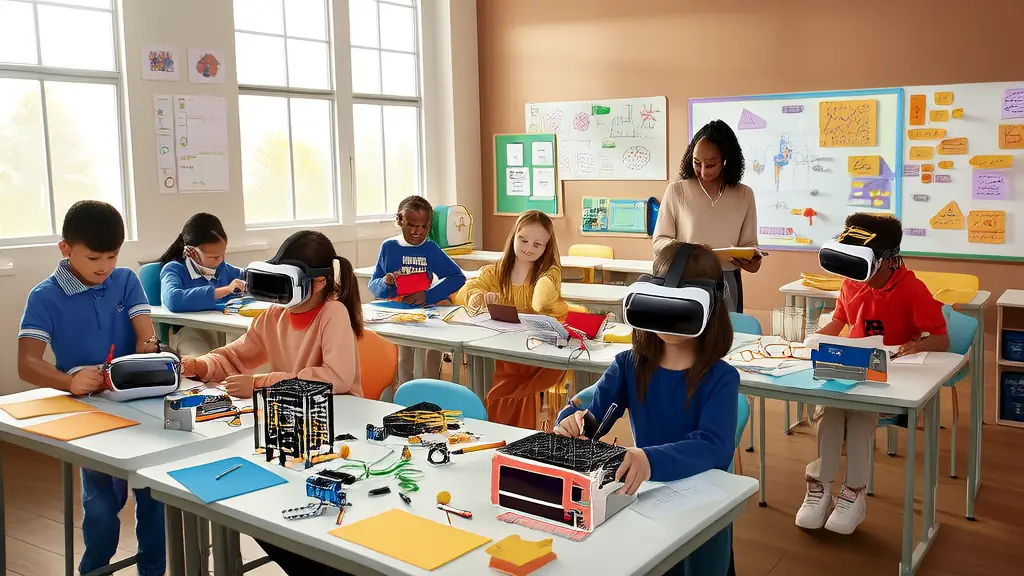
www.uitgedu.com | 自然英语拼读 | KET | PET | 英语点读学习资料
Empowering the Future: Navigating K12 Education in 2025
As we step into the second half of 2025, the landscape of K12 education continues to evolve at a rapid pace. Parents and educators are more engaged than ever, seeking not just to teach but to inspire and prepare students for an increasingly complex world. This blog post aims to shed light on the latest teaching methodologies, child development insights, and educational technology trends that are shaping the future of learning. We will also share practical tips and success stories that can help both parents and teachers foster a nurturing and effective learning environment.
Latest Teaching Methodologies and Their Effectiveness
In recent years, there has been a significant shift towards student-centered learning approaches. Project-Based Learning (PBL) and Blended Learning are two methodologies that have gained widespread recognition for their ability to engage students and enhance critical thinking skills.
Project-Based Learning (PBL): PBL involves students working on long-term projects that require them to apply multiple skills and knowledge areas. For example, a middle school class might work on a project to design a sustainable city, integrating concepts from science, math, and social studies. Research shows that PBL can lead to deeper understanding and better retention of material, as well as improved problem-solving and collaboration skills.
Blended Learning: Blended learning combines traditional face-to-face classroom instruction with online digital media. This approach allows for personalized learning, where students can progress at their own pace and access additional resources. A study by the Clayton Christensen Institute found that blended learning can lead to higher student engagement and improved academic performance, especially when combined with adaptive learning technologies.
Child Development Insights and Research
Understanding child development is crucial for creating effective learning environments. Recent research has highlighted the importance of social-emotional learning (SEL) and executive function skills.
Social-Emotional Learning (SEL): SEL focuses on helping students develop self-awareness, self-management, social awareness, relationship skills, and responsible decision-making. Schools that integrate SEL into their curriculum have seen improvements in student behavior, attendance, and academic performance. For example, the CASEL (Collaborative for Academic, Social, and Emotional Learning) framework provides a structured approach to implementing SEL in schools.
Executive Function Skills: These are the cognitive processes that enable us to plan, focus attention, remember instructions, and juggle multiple tasks. Research from the Harvard Center on the Developing Child indicates that executive function skills are critical for academic success and lifelong well-being. Teachers can support these skills by providing clear instructions, breaking tasks into manageable steps, and offering opportunities for practice and feedback.
Educational Technology Trends
Technology continues to play a pivotal role in K12 education, with new tools and platforms emerging to support both teaching and learning. Some of the key trends include:
Adaptive Learning Platforms: These platforms use algorithms to tailor content and pacing to individual student needs. For instance, DreamBox Learning offers personalized math lessons that adjust based on a student's performance. Adaptive learning can help close achievement gaps and ensure that all students are challenged and supported.
Virtual and Augmented Reality (VR/AR): VR and AR technologies are being used to create immersive learning experiences. For example, Google Expeditions allows students to take virtual field trips to historical sites, museums, and even outer space. These experiences can make learning more engaging and memorable, particularly for subjects like history and science.
Artificial Intelligence (AI) in Education: AI is being integrated into various aspects of education, from grading and assessment to personalized tutoring. Tools like Carnegie Learning's MATHia use AI to provide real-time feedback and support to students as they work through math problems. AI can help teachers identify areas where students need additional support and provide targeted interventions.
Practical Tips for Parents and Teachers
Here are some actionable tips for parents and teachers to support student success:
- For Parents:
- Stay involved in your child's education by attending parent-teacher conferences and staying in regular communication with teachers.
- Create a supportive home learning environment with a dedicated study space and a consistent routine.
- Encourage your child to set goals and reflect on their progress regularly.
- For Teachers:
- Integrate SEL and executive function activities into your daily lessons to support holistic development.
- Use formative assessments to monitor student progress and provide timely feedback.
- Explore and incorporate educational technology tools that align with your teaching goals and student needs.
Success Stories and Case Studies
Real-world examples can provide inspiration and practical insights. Here are a few success stories:
The Summit Public Schools Network: Summit Public Schools, a network of charter schools in California, has implemented a personalized learning model that uses technology to support individualized instruction. Students set goals, track their progress, and receive one-on-one mentoring. The results have been impressive, with high graduation rates and strong college acceptance numbers.
High Tech High (HTH): HTH, a network of charter schools in San Diego, emphasizes project-based learning and real-world applications. Students work on interdisciplinary projects that culminate in public exhibitions. HTH has achieved high levels of student engagement and academic success, with many graduates going on to top colleges and universities.
Conclusion
The future of K12 education is bright, with innovative teaching methodologies, cutting-edge technology, and a growing understanding of child development. By embracing these advancements and working together, parents and educators can create learning environments that empower students to reach their full potential. Whether you are a parent or a teacher, stay informed, stay engaged, and continue to seek out new ways to support and inspire the next generation.
Let's work together to build a brighter future for our children. If you have any questions or would like to share your own success stories, please leave a comment below. Together, we can make a difference!